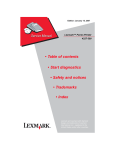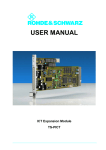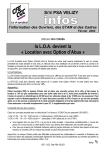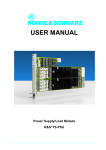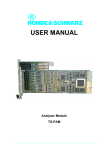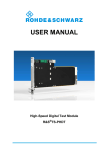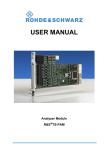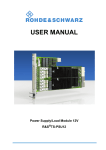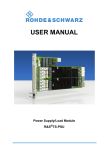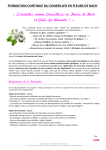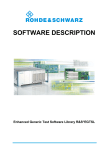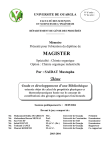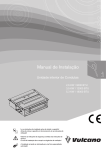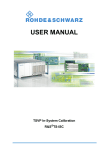Download USER MANUAL - Rohde & Schwarz
Transcript
USER MANUAL Analog Stimulus and Measurement Module TS-PSAM User Manual for ROHDE & SCHWARZ Analog Stimulus and Measurement Module TS-PSAM 6th Issue / 11.05 / GB 1142.9878.12 All rights, also translation into foreign languages, are reserved. No part of this manual is permitted to be reproduced in any form (print, photocopy or any other method), also not for the preparation of lectures, or processed, reproduced or made available using electronic systems without written permission from ROHDE & SCHWARZ. © The passing on to third parties and the reproduction of this documentation, utilisation and communication of its contents is not permitted unless specifically approved. Infringements will incur claims for damages. All rights reserved in the case of the award of a patent or registration of a design. We draw to your attention that the names of software and hardware used in the Service Manual, and the brand names of the respective companies are, in general, the subject of protection as trademarks, or under proprietary rights, or patent law. ROHDE & SCHWARZ GmbH & Co. KG Corporate Headquarters Mühldorfstr. 15 D-81671 München Telephone: Fax: ...49 (0)89/4129-13774 ...49 (0)89/4129-13777 Printed in the Federal Republic of Germany. Errors excepted, subject to technical change without notice. Safety Instructions Attention! Electrostatic sensitive devices require special care Support Center Telephone Europe: +49 180 512 42 42 Telephone worldwide: +49 89 4129 13774 Fax: +49 89 4129 13777 e-mail: [email protected] If you have any technical queries about this Rohde & Schwarz equipment, our Hotline at the Support Center of Rohde & Schwarz Sales-GmbH will be glad to help. Our team will discuss your queries and look for solutions to your problems. The Hotline is open Mondays to Fridays from 08.00 to 17.00 hrs. For queries outside office hours, you can leave a message or send a note via fax or email. We will then get back to you as soon as possible. Analog Stimulus and Measurement Module TS-PSAM Content Content 1 Usage 1-1 1.1 General 1-1 1.2 Features of the TS-PSAM 1-2 1.2.1 Hardware Components 1-2 1.2.2 1.2.2.1 1.2.2.2 Applications Examples of use Expanded applications 1-3 1-4 1-6 1.2.3 Features of the TS-PDC module 1-8 2 View 2-1 3 Block diagrams 3-1 4 Layout 4-1 4.1 Mechanical construction of the TS-PSAM 4-1 4.2 Display elements on the TS-PSAM module 4-3 4.3 Mechanical construction of the TS-PDC 4-4 4.4 Display elements of the TS-PDC module 4-5 5 Function Description 5-1 5.1 Function description of the TS-PSAM module 5-1 5.1.1 Primary matrix and analog measuring bus 5-1 5.1.2 Discharge unit DCH 5-3 5.1.3 Trigger logic 5-4 5.2 6 6th Issue 11.05 7 8 Function Description of the TS-PDC Module 5-7 Commissioning 6-1 6.1 Installing the TS-PSAM Module 6-1 6.2 Installing the TS-PDC Module 6-2 Software 7-1 7.1 Driver Software 7-1 7.2 Soft Panel 7-2 7.3 TS-PSAM Programming Example 7-3 Self-Test 8-1 8.1 8-1 LED Test: 3 Content 9 Analog Stimulus and Measurement Module TS-PSAM 8.2 Power-on test 8-2 8.3 TSVP Self-Test 8-2 Interface description 9-1 9.1 Interface description for TS-PSAM 9-1 9.1.1 Connector X10 (Front Connector) 9-1 9.1.2 Connector X20 (Extension Connector) 9-3 9.1.3 Connector X30 (Analog Bus Connector) 9-4 9.1.4 Connector X1 (cPCI Bus Connector) 9-5 9.2 Interface description for TS-PDC 9-6 9.2.1 9-6 Connector X20 (Extension Connector) 10 Specifications 10.1 Technical Specifications for the TS-PSAM Module 10-1 10.1.1 10.1.1.1 10.1.1.2 DC voltage source Voltage adjustment Current limiting 10-1 10-1 10-1 10.1.2 10.1.2.1 10.1.2.2 10.1.2.3 10.1.2.4 Measurement unit Voltage Current RMS value measurement Resistance measurement 10-2 10-2 10-3 10-4 10-8 10.1.3 Discharge circuit 10-9 10.1.4 Analog bus and relay multiplexer 10-9 10.1.5 General Data 10-9 Technical Specifications for the TS-PDC Module 10-10 10.2.1 Electrical Specifications 10-10 10.2.2 General Data 10-10 6th Issue 11.05 10.2 10-1 4 Analog Stimulus and Measurement Module TS-PSAM Figures 6th Issue 11.05 Figures Figure 1-1 Cross-connection for 2-wire resistance measuring in Mode C............................................................................................1-4 Figure 1-2 Cross-connection for 4-wire resistance measuring in Mode C............................................................................................1-4 Figure 1-3 Cross-connection for 2-wire resistance measuring in Mode V............................................................................................1-5 Figure 1-4 Cross-connection for 4-wire resistance measuring in Mode V............................................................................................1-5 Figure 1-5 Cross-connection in a guarded resistance measurement (6-wire) ................................................................................................1-6 Figure 1-6 Cross-connection in a guarded impedance measurement (6-wire) ................................................................................................1-7 Figure 2-1 View of the TS-PSAM module...........................................................2-1 Figure 2-2 View of the TS-PDC rear I/O module. ...............................................2-2 Figure 3-1 Block Diagram of TS-PSAM ..............................................................3-1 Figure 3-2 Block Diagram of TS-PDC.................................................................3-2 Figure 3-3 Functional block diagram of TS-PSAM with TS-PDC in the CompactTSVP ....................................................................................3-2 Figure 4-1 Arrangement of connectors and LEDs on the TS-PSAM module .4-1 Figure 4-2 Arrangement of LEDs on the TS-PSAM module .............................4-3 Figure 4-3 Arrangement of the connector and LEDs on the TS-PDC module 4-4 Figure 4-4 Arrangement of LEDs on the TS-PDC module................................4-5 Figure 5-1 Block Diagram of TS-PSAM ..............................................................5-5 Figure 5-2 Block Diagram of the Trigger Hardware ..........................................5-6 Figure 5-3 Block Diagram of TS-PDC.................................................................5-7 Figure 7-1 Soft PanelTS-PSAM ...........................................................................7-2 Figure 9-1 Connector X10 (mating side) ............................................................9-1 Figure 9-2 Connector X20 (mating side) ............................................................9-3 Figure 9-3 Connector X30 (mating side) ............................................................9-4 Figure 9-4 Connector X1 (mating side) ..............................................................9-5 Figure 9-5 Connector X20 (TS-PDC mating side)..............................................9-6 5 Analog Stimulus and Measurement Module TS-PSAM 6th Issue 11.05 Figures 6 Analog Stimulus and Measurement Module TS-PSAM Tables Tables Connectors on the TS-PSAM module ..............................................4-2 Table 4-2 LEDs on the TS-PSAM module.........................................................4-3 Table 4-3 Connector for the TS-PDC module ..................................................4-4 Table 4-4 Display elements on the TS-PDC module .......................................4-5 Table 7-1 Driver InstallationTS-PSAM ..............................................................7-1 Table 8-1 Statements about the LED Test........................................................8-1 Table 8-2 Statements about the power-on test................................................8-2 Table 9-1 Pin assignment for connector X10...................................................9-1 Table 9-2 Pin assignment for connector X20...................................................9-3 Table 9-3 Pin assignment for connector X30...................................................9-4 Table 9-4 Pin assignment for connector X1.....................................................9-5 Table 9-5 Pin assignment for connector X20 (TS-PDC)..................................9-7 6th Issue 11.05 Table 4-1 7 Analog Stimulus and Measurement Module TS-PSAM 6th Issue 11.05 Tables 8 Analog Stimulus and Measurement Module TS-PSAM Usage 1 Usage 1.1 General The TS-PSAM Analog Stimulus and Measurement Module is a measurement module for the CompactTSVP (Test System Versatile Platform) universal test platform. The module is used to perform analog measuring tasks, in-circuit measurements, and the CompactTSVP selftest. The module's floating DC supply voltage is provided via the associated TS-PDC rear I/O module. This is inserted in the appropriate rear I/O slot in the back of the device (same slot number as TS-PSAM). The TS-PSAM module is inserted in the front of the CompactTSVP chassis. It is based on the cPCI/PXI standard. The front connector ends flush with the front panel of the CompactTSVP chassis and is used for contacting the test products or measurement sensors. At the back, the TS-PSAM module is connected to the cPCI control bus and the PXI trigger bus. Instead of using the front connector, analog measurement signals can be captured via the CompactTSVP's analog measuring bus. 6th Issue 11.05 A LabWindows IVI DMM driver is provided for the DMM functions on the card. All other hardware functions are controlled using specific extensions of the driver. As is typical for a LabWindows CVI driver, Function Panels and Online Help are available. 1-1 Usage Analog Stimulus and Measurement Module TS-PSAM 1.2 Features of the TS-PSAM 1.2.1 Hardware Components The TS-PSAM modules includes a ground-connected discharge circuit, an floating programmable voltage source, and an floating measurement unit. These components can be switched into the CompactTSVP's analog bus via a relay matrix. Measuring tasks can be synchronized using triggered measurements across the PXI bus and the trigger inputs on the front connector. Two relay multiplexers with four channels each are also provided. The major features of these three function blocks will be explained in detail in the following section: – floating DC voltage source (DCS) • adjustable voltage and current limiting • • • • ±5 V, 100 mA max. fast settling time four-quadrant operation sense wires floating measurement unit (MU) • • • • • • – • 10 mV - 125 V • 1 µA - 1 A Measurement range AC rms • 20 mV - 125 V • 100 µA - 1 A triggered measurements across the PXI Triggerbus 2 triggers derived from the measurement signal with programmable threshold 4 filters 16-bit converter • Sampling rate 200 kHz (max. ) • Single or „multipoint“ measurement with storage depth up to 8 k samples Discharge circuit (DCH) • • 1-2 Measurement range DC Discharge current 400 mA (max. ) Discharge voltage 125V (max. ) 6th Issue 11.05 – Analog Stimulus and Measurement Module TS-PSAM Usage 1.2.2 Applications On this topic see also Figure 1-1to Figure 1-6 The module is used to perform analog measuring tasks, in-circuit measurements, and the CompactTSVP self-test. In these tests, the module functions as a measuring device with adjustable sampling rate for voltage, current and resistance measurements. The measurement unit and the adjustable DC voltage source are cross-connected with each other in a suitable manner for measuring resistance. If necessary, the source can also be connected with GND. The measurement unit and the DC voltage source can also be operated independently of one another. In the in-circuit test (ICT), the TS-PSAM module performs the following measuring tasks: Discharging capacitors – 2- and 4-wire resistance measurements ( Figure 1-1 to Figure 1-4 ) – Contact test – Short circuit test – Connection test 6th Issue 11.05 – 1-3 Usage Analog Stimulus and Measurement Module TS-PSAM 1.2.2.1 Examples of use On this topic see also Figure 1-1 to Figure 1-4 Resistance measurements are taken with the aid of the DC voltage source and the measurement unit. 2- and 4-wire measurements are possible. Two different procedures may be followed depending on the resistance value to be measured. If necessary, the source can be connected to GND. • Mode C for small resistances In this method, a constant current is applied and the voltage is measured. (see Figure 1-1 and Figure 1-2) HI DCS = Rx V MU LO Figure 1-1 Cross-connection for 2-wire resistance measuring in Mode C HI RS SHI = Rx V MU SLO LO RM Figure 1-2 Cross-connection for 4-wire resistance measuring in Mode C 1-4 6th Issue 11.05 DCS Analog Stimulus and Measurement Module TS-PSAM • Usage Mode V for large resistances In this method, the voltage is applied and the current is measured. (see Figure 1-3 and Figure 1-4 ) HI DCS = Rx MU A LO Figure 1-3 Cross-connection for 2-wire resistance measuring in Mode V RS HI SHI DCS = Rx MU A SLO 6th Issue 11.05 LO RM Figure 1-4 Cross-connection for 4-wire resistance measuring in Mode V 1-5 Usage Analog Stimulus and Measurement Module TS-PSAM 1.2.2.2 Expanded applications On this topic, see also Figure 1-5 and Figure 1-6 Further in-circuit measurements can be made in conjunction with the TS-PICT module (ICT expansion module). These are: – Diode and transistor test – Guarded resistance measurements (3, 4 and 6 wires) – Impedance measurements (3, 4 and 6 wires) For this purpose, the TS-PICT module provides a special AC voltage source (AOS) and current measurement unit (CMU). The UUT is connected for the in-circuit test (ICT) via the TS-PMB module (matrix module B). 1.2.2.2.1 Examples of use On this topic, see also Figure 1-5 and Figure 1-6 The following section presents some examples of cross-connection for guarded measurements. A1 A2 DCS = R1 C Rx D B2 R2 B1 Figure 1-5 Cross-connection in a guarded resistance measurement (6-wire) 1-6 6th Issue 11.05 CMU A Analog Stimulus and Measurement Module TS-PSAM Usage 6th Issue 11.05 Figure 1-6 Cross-connection in a guarded impedance measurement (6-wire) 1-7 Usage Analog Stimulus and Measurement Module TS-PSAM 1.2.3 Features of the TS-PDC module The TS-PDC module is used as an floating DC voltage source for the TS-PSAM module. It is configured with two identical DC/DC converters. The following floating direct voltages are obtained from an input voltage of 5 VDC: +15 VDC ±5%, 0.5A (2x) – -15 VDC ±5%, 0.5A (2x) – +5 VDC ±5%, 0.5A (2x) – +3.3 VDC ±5%, 0.25A (2x) 6th Issue 11.05 – 1-8 Analog Stimulus and Measurement Module TS-PSAM View 2 View Figure 2-2 shows the TS-PSAM module without the associated TS-PDC rear I/O module. The TS-PDC rear I/O module is shown in Figure 2-2. 6th Issue 11.05 Figure 2-1 View of the TS-PSAM module 2-1 View Analog Stimulus and Measurement Module TS-PSAM 6th Issue 11.05 Figure 2-2 View of the TS-PDC rear I/O module. 2-2 Analog Stimulus and Measurement Module TS-PSAM Block diagram 3 Block diagrams Analog Bus Connector X30 Figure 3-1 shows the block diagram of the TS-PSAM module and Figure 3-2 shows the block diagram of the TS-PDC module. Figure 3-3 is a simplified functional block diagram of both modules in the CompactTSVP. a1 Analog Bus (AB) DCH a2 b1 b2 c1 c2 d1 d2 DCH_HI DCS_HI DCS DCS_SHI DCS_SLO SENSE DCS_LO MU_SHI MU_SLO MU_LO Local Analog Bus (LAB) Isolation PXI_TRIG0.. PXI_TRIG7 XTA1, XTA2 a1 a2 b1 b2 c1 c2 d1 Front Connector X10 MU_HI MU MU d2 XTO1, XTO2 Trigger XTI1, XTI2 Extension Connector X20 AUX1, AUX2 RACH1 RACH2 RACH3 GA0..GA4 G e og ra p h ic A d dre s sin g RACH4 S P I In te rfa c e RBCH1 RACOM CPCI Bus Connector X1 6th Issue 11.05 RBCH2 C PCI Inte rf ac e RBCH3 RBCH4 RBCOM GND GND CHA-GND ~ = ~ = Figure 3-1 Block Diagram of TS-PSAM 3-1 Analog Stimulus and Measurement Module TS-PSAM +5 V GND Regulator 1 +15 V +5 V +3.3 V COM -15 V Regulator 2 +15 V +5 V +3.3 V COM -15 V primary DC-Transducer ON/OFF X 20 Block diagram INHIBIT Figure 3-3 Functional block diagram of TS-PSAM with TS-PDC in the CompactTSVP 3-2 6th Issue 11.05 Figure 3-2 Block Diagram of TS-PDC Analog Stimulus and Measurement Module TS-PSAM Layout 4 Layout 4.1 Mechanical construction of the TS-PSAM On this topic, see also Figure 4-1 The TS-PSAM module is designed as a long cPCI plug-in module for mounting in the front of the CompactTSVP. The board height of the module is 3 HU (134 mm). In order to ensure that it is inserted correctly into the Compact TSVP, the front panel is furnished with a locating pin. The module is secured in place with the two retaining screws on the front panel. Front connector X10 is used for connecting the UUTs. Connector X30 connects the TS-PSAM module to the analog bus backplane in the CompactTSVP. Connectors X20/X1 connect the TS-PSAM module to the cPCI backplane/PXI control backplane. 6th Issue 11.05 Figure 4-1 Arrangement of connectors and LEDs on the TS-PSAM module 4-1 Layout Analog Stimulus and Measurement Module TS-PSAM Symbol Use X1 cPCI Bus X10 UUT X20 Extension (PXI), Rear I/O X30 Analog Bus 6th Issue 11.05 Table 4-1 Connectors on the TS-PSAM module 4-2 Analog Stimulus and Measurement Module TS-PSAM Layout 4.2 Display elements on the TS-PSAM module On this topic, see also Figure 4-2 Three light-emitting diodes (LEDs) are located on the front of the TSPSAM module to show the current status of the module. These LEDs have the following meanings: Figure 4-2 Arrangement of LEDs on the TS-PSAM module LED Description red Fault condition (ERR): Lights up when a fault is detected on the TS-PSAM module during the power-on test after the supply voltage is switched on. This means that there is a hardware problem on the module. (see also Section 8 “Self-test“) yellow Communication (COM): Lights up when data is exchanged across the interface. green Supply voltage OK (PWR): Lights up when all necessary supply voltages are present (inc. the TS-PDC voltages). 6th Issue 11.05 Table 4-2 LEDs on the TS-PSAM module 4-3 Layout Analog Stimulus and Measurement Module TS-PSAM 4.3 Mechanical construction of the TS-PDC On this topic, see also Figure 4-3 The TS-PDC module is a rear I/O module for mounting in the back of the CompactTSVP. The board height of the module is 3 HU (134 mm). The module is secured in place with the two retaining screws on the front panel. Connector X20 connects the TS-PDC module to the extension backplane in the CompactTSVP. The TS-PDC module must always use the corresponding rear I/O slot for the main module (e.g. TSPSAM module). WARNING! The TS-PDC module must always be inserted in the corresponding rear I/O slot (same slot code) of the TS-PSAM module. If modules are inserted incorrectly (e.g. cPCI/PXI standard modules in the front), both modules may be damaged irreparably. Figure 4-3 Arrangement of the connector and LEDs on the TS-PDC module X20 Use Extension (Rear I/O) Table 4-3 Connector for the TS-PDC module 4-4 6th Issue 11.05 Symbol Analog Stimulus and Measurement Module TS-PSAM Layout 4.4 Display elements of the TS-PDC module On this topic, see also Figure 4-4 Eight light-emitting diodes (LEDs) are located on the front of the TSPDC module to show the current status of the generated supply voltages. The individual LEDs have the following meanings: Figure 4-4 Arrangement of LEDs on the TS-PDC module LED Description 1, lights up +15 VDC (DCS), present 2, lights up +5 VDC (DCS), present 3, lights up +3.3 VDC (DCS), present 4, lights up -15 VDC (DCS), present 5, lights up +15 VDC (MU), present 6, lights up +5 VDC (MU), present 7, lights up +3.3 VDC (MU), present 8, lights up -15 VDC (MU), present 6th Issue 11.05 Table 4-4 Display elements on the TS-PDC module 4-5 Analog Stimulus and Measurement Module TS-PSAM 6th Issue 11.05 Layout 4-6 Analog Stimulus and Measurement Module TS-PSAM Function description 5 Function Description 5.1 Function description of the TS-PSAM module On this topic, see also Figure 5-1 and Figure 5-2 5.1.1 Primary matrix and analog measuring bus On this topic, see also Figure 5-1 The stimulus and measurements can be cross-connected in any permutation through a full matrix to a local analog bus (8-wires LABx). The discharge circuit can only be connected to wires a1 and a2. Cross-connection to the TSVP's analog measuring bus is possible via separate bus coupling relays. Configuration relays The following relays are used for internal configuration: • Ground relays • MU and DCS configuration relays Voltage and current measurement unit (MU) (MU = Measurement Unit) AC and DC voltages and currents are measured with the MU. Both MU inputs can be switched into the local 8-wire analog bus via the full matrix. DC voltage measurement 6th Issue 11.05 The DC voltage measurement unit (MU) is a floating measuring device with programmable pre-filtering and adjustable input voltage ranges. Analog/Digital conversion is performed with a serial A/D converter whose output data are stored in a FIFO memory. Low Pass Filter (-3 dB): (MU Filter) 4 ranges, 400 Hz, 4 kHz, 40 kHz, 100 kHz (the same applied for current measurements) Voltage ranges: see specifications Overvoltage protection: 200 V max. Analog bandwidth (-3 dB): >500 kHz 5-1 Function description Analog Stimulus and Measurement Module TS-PSAM A/D converter: Resolution: 16-bit sampling rate: 200 kHz max. FIFO: 8k AC voltage measurement AC voltage is measured using an RMS-to-DC converter. AC voltage that is present at the inputs is converted to a DC output voltage that is proportional to the real RMS value of the input signal. The converted DC output voltage is processed by the A/D converter. DC current measurement The measurement unit for current is capable of taking readings in a range from a few hundred nanoamperes to a 1 A. It can be switched into the 8-wire analog bus without limitation through a full matrix. Currents larger than 100 mA are measured using a shunt resistor. On the other hand, currents smaller than 100 mA are measured actively using a current-voltage converter (I/U converter). AC current measurement The AC current is converted to an AC voltage using a shunt or I/U converter; the AC voltage is converted to a DC voltage with an RMS-to-DC converter, and the DC voltage is processed by the A/D converter. DC stimulus source (DCS) (DCS = DC Source) The DCS is a potentialless, programmable DC voltage source with adjustable current limiting and sense wires for compensating voltage drops in circuits to the load. Depending on the test requirements, it can function either in voltage mode or in current limiting mode. DC stimulus source specification Voltage range: 0 ... ±5 V Current: 0 ... ±100 mA max. Current limiting mode 5-2 Voltage range: ±0.1 V ... ±5 V max. Current limit ranges: ±100 mA, 10 mA, 1 mA, 0.1 mA 6th Issue 11.05 Voltage mode Analog Stimulus and Measurement Module TS-PSAM Function description Resistance measurement With the DC Stimulus (DCS) and current measurement unit (MU), resistances can be measured in the following ways: • A known DC voltage Vs is applied to the resistor that is to be measured and the resulting current Ix is measured with the MU. • A known DC current Is is applied to the resistor via the DCS and the resulting drop in voltage Vx at the resistor is measured with the MU. 5.1.2 Discharge unit DCH (DCH = Discharge Unit) The discharge unit is provided to enable the controlled discharge of capacitors on the UUT, to prevent the circuit relays in the test system from being irreparably damaged or the UUT from becoming charged as a result of the test procedure. For this purpose, a constant discharge current is generated with an active current limiter. The circuit is protected against overload by an integrated heat cutout. The residual voltage after discharge is typically less than 100 mV. The DCH can be connected to the local analog bus via relays. In order to minimize loading on the circuit relays, the circuit path should be set first, before the DCH is activated. 6th Issue 11.05 Specifications Discharge current ranges: (typical) 400 mA, 275 mA, 150 mA and 10 mA Discharge mode: Constant current Maximum voltage: ±125 VDC Discharge residual voltage: <100 mVDC Discharge power: (average) 2 W max. Overvoltage protection: 200 VDC max. Overload protection: Thermal sensor 5-3 Function description Analog Stimulus and Measurement Module TS-PSAM 5.1.3 Trigger logic On this topic, see also Figure 5-2 The TS-PSAM module can be synchronized with other system components by trigger signals from the PXI trigger bus, or by local trigger events or “software triggers“ . In all such events, the TS-PSAM module can function as a “trigger master“ or “ a trigger slave“. Trigger inputs The internal FPGA Hardware uses the global trigger input signals from the PXI trigger bus (PXI_TRIG0 ... PXI_TRIG7) and the local TTL trigger inputs on the front connector (XTI1, XTI2). In addition, the trigger signals (XTA1, XTA2) derived from the analog input signal and the four internal feedback trigger circuits of the trigger logic blocks (IT01 ... IT04) are all used to detect a trigger event. The signals to be considered and their levels (high/low) are selected in configuration registers. Trigger logic blocks The FPGA contains four independently functioning trigger logic blocks for generating complex trigger sequences: 1. Multiple trigger pulses with various delay periods and the same time reference 2. Cascade triggers 3. Multiple trigger pulses with adjustable duty factor 4. Trigger logic blocks 3 and 4 are reserved for internal use (DCS, ADC), blocks1 and 2 are available to the user Trigger outputs 6th Issue 11.05 The outputs from the trigger logic blocks can be switched to the trigger outputs on the front connector (XTOx) and to the PXI trigger bus (PXI_TRIGx). The polarity of the trigger signal is programmable. The trigger output signals are TTL compatible and are buffered using driver circuits. 5-4 Analog Bus Connector X30 Analog Stimulus and Measurement Module TS-PSAM a1 Analog Bus (AB) DCH DCS a2 Function description b1 b2 c1 c2 d1 d2 DCH_HI DCS_HI DCS_SHI DCS_SLO SENSE DCS_LO MU_HI MU_SHI MU_SLO MU_LO Local Analog Bus (LAB) Isolation PXI_TRIG0.. PXI_TRIG7 XTA1, XTA2 a1 a2 b1 b2 c1 c2 d1 Front Connector X10 MU MU d2 XTO1, XTO2 Trigger XTI1, XTI2 Extension Connector X20 AUX1, AUX2 RACH1 RACH2 RACH3 GA0..GA4 G e og rap h ic A d dres sin g RACH4 SP I In te rfa ce RBCH1 RACOM CPCI Bus Connector X1 6th Issue 11.05 RBCH2 CPCI Inte rface RBCH3 RBCH4 RBCOM GND GND CHA-GND ~ = ~ = Figure 5-1 Block Diagram of TS-PSAM 5-5 Analog Stimulus and Measurement Module TS-PSAM 6th Issue 11.05 Function description Figure 5-2 Block Diagram of the Trigger Hardware 5-6 Analog Stimulus and Measurement Module TS-PSAM Function description 5.2 Function Description of the TS-PDC Module On this topic, see also Figure 5-3 The DC/DC converter is configured as a primary reference DC/DC converter. The input voltage (5 VDC) is transfered to two secondary potentials and rectified to the nominal voltage by line controllers. The status of the output voltage is displayed in each case by an LED. – +15 VDC, 0.5A (2x) – -15 VDC, 0.5A (2x) – +5 VDC, 0.5A (2x) – +3.3 VDC, 0.25A (2x) +5 V GND Regulator 1 +15 V +5 V +3.3 V COM -15 V Regulator 2 +15 V +5 V +3.3 V COM -15 V primary DC-Transducer ON/OFF X 20 The following DC voltages are generated: INHIBIT 6th Issue 11.05 Figure 5-3 Block Diagram of TS-PDC 5-7 Analog Stimulus and Measurement Module TS-PSAM 6th Issue 11.05 Function description 5-8 Analog Stimulus and Measurement Module TS-PSAM Commissioning 6 Commissioning 6.1 Installing the TS-PSAM Module To install the plug-in module, proceed as follows: • Power down and switch off the CompactTSVP • Select a suitable front slot (slots 5-15 possible, preferably slot 8). TS-PSAM should be connected to slot 8 and TS-PICT to slot 9 for an in-circuit test configuration. • Remove the corresponding front panel portion from the TSVP chassis by loosening the two screws WARNING! Check the backplane connectors for bent pins! Any bent pins must be straightened! Failure to do this may permanently damage the backplane! • Apply moderate pressure to insert the plug-in module (use locating pin to attach) WARNING! To insert the plug-in module, use both hands to guide carefully into the backplane connectors. • The module is correctly located when a distinct 'stop' can be felt. • Tighten the two retaining screws on the front panel of the module. WARNING! 6th Issue 11.05 Install the associated TS-PDC rear I/O module as described in Section 6.2. 6-1 Commissioning Analog Stimulus and Measurement Module TS-PSAM 6.2 Installing the TS-PDC Module To install the plug-in module, proceed as follows: • The TS-PSAM module must have been installed beforehand • Select the corresponding rear I/O slot for the TS-PSAM module • Remove the corresponding rear panel portion from the CompactTSVP chassis by loosening the two screws WARNING! Check the backplane connectors for bent pins! Any bent pins must be straightened! Failure to do this may permanently damage the backplane! • Push in the plug-in module using moderate pressure WARNING! To insert the plug-in module, use both hands to guide carefully into the backplane connectors. The module is correctly located when a distinct 'stop' can be felt. • Tighten the two retaining screws on the front panel of the module. 6th Issue 11.05 • 6-2 Analog Stimulus and Measurement Module TS-PSAM Software 7 Software 7.1 Driver Software A LabWindows IVI DMM driver is provided for the DMM functions on the card. All other hardware functions are controlled using specific extensions of the driver. The driver is part of the ROHDE & SCHWARZ GTSL software. All the functions of the driver are described fully in the on-line help and in the LabWindows CVI Function Panels. The following software modules are installed during driver installation: Module Path Remarks rspsam.dll <GTSL Directory>\Bin Driver rspsam.hlp <GTSL Directory>\Bin Help file rspsam.fp <GTSL Directory>\Bin LabWindows CVI Function Panel File, Function Panels for CVI Development Environment rspsam.sub <GTSL Directory>\Bin LabWindows CVI Attribute File. This file is needed by some „Function Panels“. rspsam.lib <GTSL Directory>\Bin Import Library rspsam.h <GTSL Directory>\Include Header File for the Driver Table 7-1 Driver InstallationTS-PSAM NOTE: 6th Issue 11.05 The IVI and VISA libraries produced by National Instruments are needed to run the driver. 7-1 Software Analog Stimulus and Measurement Module TS-PSAM 7.2 Soft Panel On this topic, see also Figure 7-1 A soft panel TS-PSAM is provided for the module. The soft panel is based on the LabWindows CVI driver. It enables the measurement module to be operated interactively. The measurement values are output in digital or graphical format (Multipoint Measurements). 6th Issue 11.05 Figure 7-1 Soft PanelTS-PSAM 7-2 Analog Stimulus and Measurement Module TS-PSAM Software 7.3 TS-PSAM Programming Example /* Simple voltage measurement with TS-PSAM */ #include "rspsam.h" main() { ViSession handle; ViReal64 result; rspsam_InitWithOptions ("PXI1::14::0::INSTR", VI_TRUE, VI_TRUE, "", & handle); rspsam_Connect (handle, "DMM_HI", "ABa1"); rspsam_Connect (handle, "DMM_LO", "ABc1"); rspsam_ConfigureMeasurement(handle,RSPSAM_VAL_DC_VOLTS, RSPSAM_VAL_AUTO_RANGE_ON, 0.0001); rspsam_Read (handle, 5000, & result); rspsam_close (handle); 6th Issue 11.05 } 7-3 Analog Stimulus and Measurement Module TS-PSAM 6th Issue 11.05 Software 7-4 Analog Stimulus and Measurement Module TS-PSAM Self-Test 8 Self-Test The Analog Stimulus and Measurement Module TS-PSAM has integrated self-test capability. The following tests are possible: • LED Test: • Power-on test • TSVP self-test 8.1 LED Test: When the device is switched on, all three LEDs are lit for about one second. This indicates that the 5 V supply voltage is present and all LEDs are working, also that the power-on test was successful. The following statements can be made about the different LED statuses in this power-on phase: LED Description One LED does not light up Hardware problem on the module LED faulty No LED's light up No +5V supply Table 8-1 Statements about the LED Test NOTE: 6th Issue 11.05 If diagnostics suggest a problem with the supply voltage, the LEDs for the associated rear I/O module, TS-PDC, must be inspected visually. If a supply voltage failure is confirmed, the TSPDC module must be replaced. 8-1 Self-Test Analog Stimulus and Measurement Module TS-PSAM 8.2 Power-on test The power-on test runs at the same time as the LED test. In this test, the result of the FPGA loading process is calculated. The following statements can be made about the different statuses of the red and green LEDs: LED Description Green LED on all supply voltages present green LED off at least one supply voltage from TS-PSAM module or the TS-PDC module is not present red LED off no errors were detected red LED on The FPGA/µP was not successfully loaded Table 8-2 Statements about the power-on test NOTE: If diagnostics suggest a problem with the supply voltage, the LEDs for the associated rear I/O module, TS-PDC, must be inspected visually. If a supply voltage failure is confirmed, the TSPDC module must be replaced. 8.3 TSVP Self-Test The TSVP self-test runs an in-depth test on the module and generates a detailed log. This is done with the “Self-Test Support Library“. The TS-PSAM module is used as a measurement unit of R&S modules in the TSVP. The correct operation of the modules is ensured by measurements on the analog bus. You will find information about starting the self-test and on the sequence of necessary steps in the GTSL soft ware description or the GTSL on-line help. 8-2 6th Issue 11.05 NOTE: Analog Stimulus and Measurement Module TS-PSAM Interface description 9 Interface description Below the interface description for the TS-PSAM module and the TSPDC module is shown. 9.1 Interface description for TS-PSAM 9.1.1 Connector X10 (Front Connector) Figure 9-1 Connector X10 (mating side) 6th Issue 11.05 Pin A B C 1 LABA1 GND LABA2 2 LABB1 GND LABB2 3 LABC1 GND LABC2 4 LABD1 GND LABD2 5 GND GND GND Table 9-1 Pin assignment for connector X10 9-1 Interface description Analog Stimulus and Measurement Module TS-PSAM Pin A B C 6 IL1 GND IL2 7 GND GND GND 8 9 RACH1 RBCH1 10 RACH2 RBCH2 11 RACH3 RBCH3 12 RACH4 RBCH4 13 RACOM RBCOM 14 15 16 17 18 19 20 21 22 23 GND 25 GND GND GND 26 GND GND GND 27 AUX1 GND AUX2 28 GND GND GND 29 XTO1 GND XTO2 30 XTI1 GND XTI2 31 GND GND GND 32 GND GND CHA-GND Table 9-1 Pin assignment for connector X10 The CHA-GND signal is connected to the front panel of the TS-PSAM. The front panel is capacitively coupled to GND. 9-2 6th Issue 11.05 24 Analog Stimulus and Measurement Module TS-PSAM Interface description 9.1.2 Connector X20 (Extension Connector) 6th Issue 11.05 Figure 9-2 Connector X20 (mating side) Table 9-2 Pin assignment for connector X20 9-3 Interface description Analog Stimulus and Measurement Module TS-PSAM 9.1.3 Connector X30 (Analog Bus Connector) Figure 9-3 Connector X30 (mating side) E 7 D IL2 6 5 A IL1 ABC1 ABA1 ABB1 ABC2 2 1 B GND 4 3 C ABB2 ABA2 ABD2 ABD1 6th Issue 11.05 Table 9-3 Pin assignment for connector X30 9-4 Analog Stimulus and Measurement Module TS-PSAM Interface description 9.1.4 Connector X1 (cPCI Bus Connector) 6th Issue 11.05 Figure 9-4 Connector X1 (mating side) Pin F 25 GND 24 GND 23 GND 22 GND 21 GND 20 GND 19 GND 18 GND 17 GND 16 GND 15 GND 12..14 11 GND 10 GND 9 GND 8 GND 7 GND 6 GND 5 GND 4 GND 3 GND 2 GND 1 GND E 5V D 3.3V C ENUM# B REQ64# A 5V ACK64# AD[0] V(I/O) 5V AD[2] 5V AD[3] AD[4] 3.3V AD[5] AD[6] 3.3V GND AD[7] C/BE[0]# M66EN AD[8] AD[9] 3.3V AD[10] AD[11] V(I/O) GND AD[12] AD[13] GND AD[14] AD[15] 3.3V C/BE[1]# PAR 3.3V GND SERR# PERR# GND IPMB_SDA IPMB_SCL 3.3V LOCK# STOP# V(I/O) GND DEVSEL# TRDY# BD_SEL# IRDY# FRAME# 3.3V AD[18] AD[1] Key Area C/BE[2]# GND AD[16] AD[17] AD[19] AD[20] 3.3V GND AD[21] AD[22] GND AD[23] IDSEL C/BE[3]# AD[24] AD[25] V(I/O) GND AD[26] AD[27] GND AD[28] AD[29] AD[30] AD[31] CLK 3.3V GND REQ# GNT# GND RST# BSRSV BSRSV INTS INTP V(I/O) HEALTHY# IPMB_PWR INTD# 5V INTC# INTB# INTA# TDI TDO TMS 5V TCK 5V +12V TRST# -12V 5V Z GND GND GND GND GND GND X1 GND GND GND C GND O GND N N GND E GND C GND T GND O GND R GND GND GND GND GND GND Table 9-4 Pin assignment for connector X1 9-5 Interface description Analog Stimulus and Measurement Module TS-PSAM 9.2 Interface description for TS-PDC 9.2.1 Connector X20 (Extension Connector) 6th Issue 11.05 Figure 9-5 Connector X20 (TS-PDC mating side) 9-6 Analog Stimulus and Measurement Module TS-PSAM Pin 22 21 20 19 18 17 16 15 14 13 12 11 10 9 8 7 6 5 4 3 2 1 Pin Z GND GND GND GND GND GND GND GND A B C Interface description D E GND or NC *3) +5V *1) GND +5V *1) GND +5V *2) GND +5V *2) GND +5V *1) GND +5V *2) +5V *2) GND +5V *1) F GND GND GND GND GND GND GND GND NC NC NC NC NP +15V_1 -15V_1 +5V_1 +3.3V_1 COM_1 NP +15V_2 -15V_2 +5V_2 +3.3V_2 COM_2 NC COM_1 COM_1 COM_1 COM_1 COM_1 COM_2 COM_2 COM_2 COM_2 COM_2 NP NC NP NC NC NC NC NC NC NC *1) *2) *3) NC C O N N E C T O R NC NC GND GND GND Z NC J20 NC GND RRST# RSCLK RSDI RCS# GND A B +5V C D E *1) GND GND GND F TS-PDC V1.0 is supplied via these pins from +5V, for backplanes up to V3.x TS-PDC V1.1 is supplied via these pins or pins from *1) , for backplanes V1.x to V4.x TS-PDC V1.1 and V1.2: GND, for version V1.3: NC (Not Connected) 6th Issue 11.05 Table 9-5 Pin assignment for connector X20 (TS-PDC) 9-7 Analog Stimulus and Measurement Module TS-PSAM 6th Issue 11.05 Interface description 9-8 Analog Stimulus and Measurement Module TS-PSAM Specifications 10 Specifications NOTE: In the event of any discrepancies between data in this manual and the technical data in the data sheet, the data sheet takes precedence. 10.1 Technical Specifications for the TS-PSAM Module 10.1.1 DC voltage source 10.1.1.1 Voltage adjustment Output voltage: -5V to +5 V Resolution: approx. 200 µV Accuracy [1]: 0.2 + 5 mV Maximum output current: 100 mA Source impedance: see Current limiting [1] Accuracy: ±(% of adjustment value + absolute value) Temperature coefficient: ±(0.1 * accuracy) / °C 10.1.1.2 Current limiting 6th Issue 11.05 Range Resolution Accuracy [1] Output characteristics (Sense wires not crossconnected) 3 µA ... 100 µA 2 nA 0.25 + 1 µA max. 10 kΩ 30 µA ... 1 mA 20 nA 0.25 + 5 µA max. 1 kΩ 300 µA ... 10 mA 200 nA 0.25 + 50 µA max. 100 Ω 3 mA ... 100 mA 2 µA 0.25 + 100 µA 10 Ω [1] Accuracy in ±(% of adjustment value + absolute value) Temperature coefficient: ±(0.1 * accuracy) / °C 10-1 Specifications Analog Stimulus and Measurement Module TS-PSAM 10.1.2 Measurement unit Signal sampling rate: 200 kHz max. Memory: 8 k sampling points Triggers: PXI bus, signal with programmable threshold 10.1.2.1 Voltage 10-2 Resolution Input characteristics Accuracy averaged, [1] [2] Accuracy unaveraged, [1] [3] 10 mV [4] 0.4 µV >100 MΩ 0.02 + 80 µV 0.02 + 150 µV 20 mV [4] 0.8 µV >100 MΩ 0.02 + 80 µV 0.02 + 150 µV 50 mV [4] 2 µV >100 MΩ 0.02 + 80 µV 0.02 + 150 µV 100 mV 4 µV >100 MΩ 0.02 + 100 µV 0.02 + 200 µV 200 mV 8 µV >100 MΩ 0.02 + 100 µV 0.02 + 200 µV 500 mV 20 µV >100 MΩ 0.02 + 100 µV 0.02 + 250 µV 1 V 40 µV >100 MΩ 0.02 + 160 µV 0.02 + 400 µV 2 V 80 µV >100 MΩ 0.02 + 320 µV 0.02 + 800 µV 5 V 0.2 mV >100 MΩ 0.02 + 0.8 mV 0.02 + 1.6 mV 10 V 0.4 mV >100 MΩ 0.02 + 1.6 mV 0.02 + 3.2 mV 20 V 0.8 mV 10 MΩ 0.02 + 3.2 mV 0.02 + 6.4 mV 50 V 2 mV 10 MΩ 0.02 + 8 mV 0.02 + 16 mV 100 V 4 mV 10 MΩ 0.02 + 16 mV 0.02 + 32 mV 200 V [5] 8 mV 10 MΩ 0.02 + 64 mV 0.02 + 128 mV [1] Accuracy: ±(% of read value + absolute value) Temperature coefficient: ±(0.1 * accuracy) / °C [2] averaged over 100 sampling points, measuring time: 20 ms, 400 Hz filter [3] Signal recording: 1 ... 8 k sampling points, unaveraged, 40 kHz filter [4] ground-connected [5] max. input voltage 125 V rms 6th Issue 11.05 Range Analog Stimulus and Measurement Module TS-PSAM Specifications 10.1.2.2 Current 6th Issue 11.05 Range Resolution Input characteristics Accuracy averaged, [1] [4] Accuracy unaveraged, [1] [5] 1 µA 0.04 nA [2] 0.2 + 2 nA 0.2 + 100 nA 2 µA 0.08 nA [2] 0.2 + 4 nA 0.2 + 100 nA 5 µA 0.2 nA [2] 0.2 + 10 nA 0.2 + 100 nA 10 µA 0.4 nA [2] 0.1 + 10 nA 0.1 + 300 nA 20 µA 0.8nA [2] 0.1 + 20 nA 0.1 + 300 nA 50 µA 2 nA [2] 0.1 + 50 nA 0.1 + 300 nA 100 µA 4 nA [2] 0.1 + 100 nA 0,1 + 500 nA 200 µA 8 nA [2] 0.1 + 200 nA 0,1 + 500 nA 500 µA 20 nA [2] 0,1 + 500 nA 0.1 + 1000 nA 1 mA 40 nA [2] 0.1 + 1000 nA 0.1 + 2000 nA 2 mA 80 nA [2] 0.1 + 2000 nA 0.1 + 4000 nA 5 mA 0.2 µA [2] 0.1 + 5 µA 0.1 + 10 µA 10 mA 0.4 µA [2] 0.1 + 10 µA 0.1 + 20 µA 20 mA 0.8 µA [2] 0.1 + 20 µA 0.1 + 40 µA 50 mA 2 µA [2] 0.1 + 50 µA 0.1 + 100 µA 100 mA 4 µA [2] 0.1 + 100 µA 0.1 + 200 µA 200 mA 8 µA [3] 0.5 + 200 µA 0.5 + 400 µA 500 mA 20 µA [3] 0.5 + 500 µA 0.5 + 1000 µA 1A 40 µA [3] 0.5 + 1000 µA 0.5 + 2000 µA [1] Accuracy: ±(% of read value + absolute value) Temperature coefficient: ±(0.1 * accuracy) / °C [2] active current measurement with a current / voltage amplifier [3] 0.5 Ω Shunt [4] averaged over 100 sampling points, measuring time: 20 ms, 400 Hz filter [5] Signal recording: 1 ... 8 k sampling points, unaveraged, 40 kHz filter 10-3 Specifications Analog Stimulus and Measurement Module TS-PSAM 10.1.2.3 RMS value measurement The accuracy measurements apply only for sinus signals in the frequency range from 20 Hz to 50 kHz. This accuracy is only achieved if the input level is at least 10% of the measurement range final value. 10.1.2.3.1 AC voltage 20 mV 50 mV 100 mV 200 mV 500 mV 1V 10-4 Frequency range Accuracy [1] 20 Hz ... 50 Hz 2.5 + 100 µV 50 Hz ... 10 kHz 1.0 + 100 µV 10 kHz ... 20 kHz 1.5 + 100 µV 20 kHz ... 50 kHz 2.5 + 100 µV 20 Hz ... 50 Hz 2.5 + 150 µV 50 Hz ... 10 kHz 1.0 + 150 µV 10 kHz ... 20 kHz 1.5 + 150 µV 20 kHz ... 50 kHz 2.5 + 150 µV 20 Hz ... 50 Hz 2.5 + 200 µV 50 Hz ... 10 kHz 1.0 + 200 µV 10 kHz ... 20 kHz 1.5 + 200 µV 20 kHz ... 50 kHz 2.5 + 200 µV 20 Hz ... 50 Hz 2.5 + 500 µV 50 Hz ... 10 kHz 1.0 + 500 µV 10 kHz ... 20 kHz 1.5 + 500 µV 20 kHz ... 50 kHz 2.5 + 500 µV 20 Hz ... 50 Hz 2.5 + 500 µV 50 Hz ... 10 kHz 1.0 + 500 µV 10 kHz ... 20 kHz 1.5 + 500 µV 20 kHz ... 50 kHz 2.5 + 500 µV 20 Hz ... 50 Hz 2.5 + 1 mV 6th Issue 11.05 Range Analog Stimulus and Measurement Module TS-PSAM Range 2V 5V 10 V 20 V 50 V 6th Issue 11.05 100 V 200 V Frequency range Specifications Accuracy [1] 50 Hz ... 10 kHz 1.0 + 1 mV 10 kHz ... 20 kHz 1.5 + 1 mV 20 kHz ... 50 kHz 2.5 + 1 mV 20 Hz ... 50 Hz 2.5 + 2,5 mV 50 Hz ... 10 kHz 1.0 + 2,5 mV 10 kHz ... 20 kHz 1.5 + 2,5 mV 20 kHz ... 50 kHz 2.5 + 2,5 mV 20 Hz ... 50 Hz 2.5 + 5 mV 50 Hz ... 10 kHz 1.0 + 5 mV 10 kHz ... 20 kHz 1.5 + 5 mV 20 kHz ... 50 kHz 2.5 + 5 mV 20 Hz ... 50 Hz 2.5 + 10 mV 50 Hz ... 10 kHz 1.0 + 10 mV 10 kHz ... 20 kHz 1.5 + 10 mV 20 kHz ... 50 kHz 2.5 + 10 mV 20 Hz ... 50 Hz 2.5 + 25 mV 50 Hz ... 10 kHz 1.0 + 25 mV 10 kHz ... 20 kHz 1.5 + 25 mV 20 kHz ... 50 kHz 2.5 + 25 mV 20 Hz ... 50 Hz 2.5 + 50 mV 50 Hz ... 10 kHz 1.0 + 50 mV 10 kHz ... 20 kHz 1.5 + 50 mV 20 kHz ... 50 kHz 2.5 + 50 mV 20 Hz ... 50 Hz 2.5 + 100 mV 50 Hz ... 10 kHz 1.0 + 100 mV 10 kHz ... 20 kHz 1.5 + 100 mV 20 kHz ... 50 kHz 2.5 + 100 mV 20 Hz ... 50 Hz 2.5 + 200 mV 50 Hz ... 10 kHz 1.0 + 200 mV 10 kHz ... 20 kHz 1.5 + 200 mV 10-5 Specifications Range Analog Stimulus and Measurement Module TS-PSAM Frequency range 20 kHz ... 50 kHz [1] Accuracy [1] 2.5 + 200 mV Accuracy: ±(% of the read value + absolute value) Temperature coefficient: ±(0.1 * Accuracy) / °C averaged over 100 sampling points, measuring time: 20 ms, 40 kHz filter 10.1.2.3.2 AC current 100 µA 200 µA 500 µA 1 mA 2 mA 5 mA 10-6 Frequency range Accuracy [1] 20 Hz ... 50 Hz 2.5 + 500 nA 50 Hz ... 10 kHz 1.0 + 500 nA 10 kHz ... 20 kHz 1.5 + 500 nA 20 kHz ... 50 kHz 2.5 + 500 nA 20 Hz ... 50 Hz 2.5 + 1.25 µA 50 Hz ... 10 kHz 1.0 + 1.25 µA 10 kHz ... 20 kHz 1.5 + 1.25 µA 20 kHz ... 50 kHz 2.5 + 1.25 µA 20 Hz ... 50 Hz 2.5 + 2.50 µA 50 Hz ... 10 kHz 1.0 + 2.50 µA 10 kHz ... 20 kHz 1.5 + 2.50 µA 20 kHz ... 50 kHz 2.5 + 2.50 µA 20 Hz ... 50 Hz 2.5 + 5 µA 50 Hz ... 10 kHz 1.0 + 5 µA 10 kHz ... 20 kHz 1.5 + 5 µA 20 kHz ... 50 kHz 2.5 + 5 µA 20 Hz ... 50 Hz 2.5 + 12.5 µA 50 Hz ... 10 kHz 1.0 + 12.5 µA 10 kHz ... 20 kHz 1.5 + 12.5 µA 20 kHz ... 50 kHz 2.5 + 12.5 µA 20 Hz ... 50 Hz 2.5 + 25.0 µA 6th Issue 11.05 Range Analog Stimulus and Measurement Module TS-PSAM Range 10 mA 20 mA 50 mA 100 mA 200 mA 6th Issue 11.05 500 mA 1A Frequency range Specifications Accuracy [1] 50 Hz ... 10 kHz 1.0 + 25.0 µA 10 kHz ... 20 kHz 1.5 + 25.0 µA 20 kHz ... 50 kHz 2.5 + 25.0 µA 20 Hz ... 50 Hz 2.5 + 50 µA 50 Hz ... 10 kHz 1.0 + 50 µA 10 kHz ... 20 kHz 1.5 + 50 µA 20 kHz ... 50 kHz 2.5 + 50 µA 20 Hz ... 50 Hz 2.5 + 125 µA 50 Hz ... 10 kHz 1.0 + 125 µA 10 kHz ... 20 kHz 1.5 + 125 µA 20 kHz ... 50 kHz 2.5 + 125 µA 20 Hz ... 50 Hz 2.5 + 250 µA 50 Hz ... 10 kHz 1.0 + 250 µA 10 kHz ... 20 kHz 1.5 + 250 µA 20 kHz ... 50 kHz 2.5 + 250 µA 20 Hz ... 50 Hz 2.5 + 500 µA 50 Hz ... 10 kHz 1.0 + 500 µA 10 kHz ... 20 kHz 1.5 + 500 µA 20 kHz ... 50 kHz 2.5 + 500 µA 20 Hz ... 50 Hz 2.5 + 1.25 mA 50 Hz ... 10 kHz 1.0 + 1.25 mA 10 kHz ... 20 kHz 1.5 + 1.25 mA 20 kHz ... 50 kHz 2.5 + 1.25 mA 20 Hz ... 50 Hz 2.5 + 2.50 mA 50 Hz ... 10 kHz 1.0 + 2.50 mA 10 kHz ... 20 kHz 1.5 + 2.50 mA 20 kHz ... 50 kHz 2.5 + 2.50 mA 20 Hz ... 50 Hz 2.5 + 5 mA 50 Hz ... 10 kHz 1.0 + 5 mA 10 kHz ... 20 kHz 1.5 + 5 mA 10-7 Specifications Analog Stimulus and Measurement Module TS-PSAM Range Frequency range Accuracy [1] 20 kHz ... 50 kHz [1] 2.5 + 5 mA Accuracy: ±(% of the read value + absolute value) Temperature coefficient: ±(0.1 * Accuracy) / °C averaged over 100 sampling points, measuring time: 20 ms, 40 kHz filter 10.1.2.4 Resistance measurement Resistance measurements are taken with the aid of the DC voltage source and the measurement unit. 2- and 4-wire measurements are possible. Either of two different methods may be used depending n the range. Accuracy 0.1 Ω ... 1 Ω 1 + 5 mΩ [2] CS 0.5 V max. 100 mA 1 Ω... 10 Ω 0.5 [1] CS 0.2 V max. 10 mA 10 Ω... 100 Ω 0.5 [1] VS 0.2 V 25 mA max. 100 Ω... 1 kΩ 0.5 [1] VS 0.2 V 2.5 mA max. 1 kΩ... 10 kΩ 0.5 [1] V 0.2 V 1 mA max. 10 kΩ... 100 kΩ 1 [1] V 0.2 V 0.1 mA max. 100 kΩ... 1 MΩ 1 [1] V 1V 0.1 mA max. 1 MΩ... 10 MΩ 1 [1] V 5V 0.1 mA max. [1] Accuracy: ±(% of read value) Temperature coefficient: ±(0.1 * accuracy) / °C [2] Accuracy: ±(% of read value + absolute value) Temperature coefficient: ±(0.1 * accuracy) / °C [3] 10-8 Operating mode [3] CS V VS Voltage source 4-wire, current applied, voltage measured 2-wire, voltage applied, current measured 4-wire, voltage applied, current measured Current source 6th Issue 11.05 Range Analog Stimulus and Measurement Module TS-PSAM Specifications 10.1.3 Discharge circuit max. input voltage: 125 V Overvoltage protection up to: 200 V DC max. discharge current: 400 mA typ. 10.1.4 Analog bus and relay multiplexer Analog bus access: 8 buses Relay scanner: 2 x 4- to-1 multiplexers max. DC/AC voltage: 125 V / 125 V rms max. current: 1 A / 1 A rms Max. switching capacity 10 W / 10 VA 10.1.5 General Data Power consumption: +5 V / 5.8 A +3.3 V / 0.2 A, 30 W max. inc. TS-PDC EMC: according to EMC Directive 89/336/EEC and Standard EN61326 Safety: CE, EN61010 Part 1 Mechanical strength • Vibration test sinusoidal Sinus 5 Hz ... 55 Hz: Sinus 55 Hz ... 150 Hz: 2 g, MIL-T-28800D, class 5 0.5 g, MIL-T-28800D, class 5 6th Issue 11.05 • Vibration test random 10 Hz ... 300 Hz: Shock test: 1.2 g 40 g, MIL-STD-810. Classes 3 and 5 10-9 Specifications Analog Stimulus and Measurement Module TS-PSAM Heat resistance • Nominal temperature range: • Operating temperature range: • Storage temperature range: • Humidity: +5 ... +40°C +0 ... +50°C -40 ... +70°C +40°C, 95% rel. humidity Dimensions in mm: 316 x 174 x 20 Weight: 0.45 kg Calibration interval (recommended): 1 year 10.2 Technical Specifications for the TS-PDC Module 10.2.1 Electrical Specifications Input voltage: 5 VDC Output voltages: (2x output voltages) +15 VDC, 0.5 A -15 VDC, 0.5 A +5 VDC, 0.5 A +3.3 VDC, 0.25 A Clock frequency: 200 kHz EMC: according to EMC Directive 89/336/EEC and Standard EN61326 Safety: CE, EN61010 Part 1 Mechanical strength • Vibration test sinusoidal Sinus 5 Hz ... 55 Hz: Sinus 55 Hz ... 150 Hz: 2 g, MIL-T-28800D, class 5 0.5 g, MIL-T-28800D, class 5 • Vibration test random 10 Hz ... 300 Hz: Shock test: 10-10 1.2 g 40 g, MIL-STD-810. Classes 3 and 5 6th Issue 11.05 10.2.2 General Data Analog Stimulus and Measurement Module TS-PSAM Specifications +5 ... +40°C +0 ... +50°C -40 ... +70°C +40°C, 95% rel. humidity Dimensions in mm: 120 x 95 x 20 Weight: 0.3 kg 6th Issue 11.05 Heat resistance • Nominal temperature range: • Operating temperature range: • Storage temperature range: • Humidity: 10-11





































































